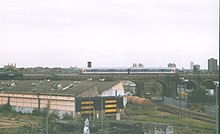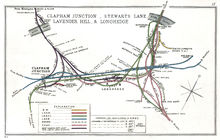| Revision as of 21:18, 16 December 2013 editEP111 (talk | contribs)Autopatrolled, Extended confirmed users394,818 edits Added infobox, Wikimedia Commons link← Previous edit | Revision as of 20:30, 20 December 2013 edit undoRedrose64 (talk | contribs)Autopatrolled, Administrators273,181 edits woopsNext edit → | ||
| (One intermediate revision by the same user not shown) | |||
| Line 1: | Line 1: | ||
| {{histmerge|Stewarts Lane TMD|reason=cut-and-paste move over pre-existing redirect}} | |||
| {{Infobox Railway Depot | {{Infobox Railway Depot | ||
| | name = Stewarts Lane TMD | | name = Stewarts Lane TMD | ||
| Line 18: | Line 19: | ||
| ] map of lines around Stewarts Lane]] | ] map of lines around Stewarts Lane]] | ||
| '''Stewarts Lane''' is a large railway servicing facility in ] in ], England, founded by the ] (LCDR) in 1862, to serve ]. It was sited in the midst of a maze of railway lines between 'Factory Junction' and 'Stewarts Lane Junction', adjacent to the site of the former ]. Prior to 1962 it was one of the largest ] in the UK. Following the ] in the early 1960s it was converted into a ] which is currently operated by ]. |
'''Stewarts Lane''' is a large railway servicing facility in ] in ], England, founded by the ] (LCDR) in 1862, to serve ]. It was sited in the midst of a maze of railway lines between 'Factory Junction' and 'Stewarts Lane Junction', adjacent to the site of the former ]. Prior to 1962 it was one of the largest ] in the UK. Following the ] in the early 1960s it was converted into a ] which is currently operated by ]. | ||
| ==Motive power depot== | ==Motive power depot== | ||
Revision as of 20:30, 20 December 2013
| It is requested that the page history of Stewarts Lane TMD be merged into the history of this page because cut-and-paste move over pre-existing redirect This action must be performed by an administrator or importer (compare pages).
Consider placing Administrators: Before merging the page histories, read the instructions at Misplaced Pages:How to fix cut-and-paste moves carefully. An incorrect history merge is very difficult to undo. Also check Misplaced Pages:Requests for history merge for possible explanation of complex cases. |
 The depot in 1998. The steam shed was situated in front of the viaduct. The depot in 1998. The steam shed was situated in front of the viaduct. | |
| Location | |
|---|---|
| Location | Battersea, United Kingdom |
| Coordinates | 51°28′21″N 0°08′38″W / 51.4725°N 0.1439°W / 51.4725; -0.1439 |
| Characteristics | |
| Owner | DB Schenker |
| Depot code | BAT (SR) 73A (British Railways) SL |
| Type | Electric, EMU |
| History | |
| Opened | 1862 |
| Original | London Chatham and Dover Railway |
| Pre-grouping | Southern Railway |
| Post-grouping | British Railways |

Stewarts Lane is a large railway servicing facility in Battersea in London, England, founded by the London Chatham and Dover Railway (LCDR) in 1862, to serve London Victoria railway station. It was sited in the midst of a maze of railway lines between 'Factory Junction' and 'Stewarts Lane Junction', adjacent to the site of the former Longhedge Railway Works. Prior to 1962 it was one of the largest motive power depots in the UK. Following the end of steam traction in the early 1960s it was converted into a Traction Maintenance Depot which is currently operated by DB Schenker.
Motive power depot

In 1860 the London, Chatham and Dover Railway purchased 75 acres (300,000 m) of land in Battersea, formerly part of the Long Hedge farm, to establish their locomotive works and the motive power depot, to provide motive power for services from the new London Victoria railway station (then under construction). The depot was originally known as ‘Longhedge’. In February 1862 a semi-roundhouse running shed was opened with space for 26 locomotives. The site was expanded in 1875/6 with 40 tracks around the central turntable, although only half were under cover.
The original depot was demolished in 1880/1 and replaced by a larger 16-road through shed on the same site, which was officially known as Stewarts Lane – but usually referred to as ‘Battersea’ or ‘Longhedge’ by the men. A coaling stage, turntable and wheel drop were provided. The depot was re-organised and a large mechanical coaling plant was added to enable the depot to deal with an increased locomotive allocation after 1932, following the closure of the nearby London Brighton and South Coast Railway Battersea shed. Stewarts Lane was provided with an asbestos roof in 1934 It suffered from bomb damage during the Second World War, some of which was never repaired. Otherwise it remained largely unchanged until closure to steam in 1963. Thereafter the tracks remained in use for stabling diesel locomotives, although much of the original building was destroyed by fire in 1967.
Traction maintenance depot
A new asbestos carriage shed was built adjacent to the running shed in the late 1950s and equipped with third rail electrification to enable it to service both electric multiple units (EMUs) and electric locomotives. During the 1960s the former goods shed on the site was also converted to service diesel and electric locomotives, and both remain in use for the Stewarts Lane Traction maintenance depot. The depot is currently operated by DB Schenker.
Shed codes
Under Southern Railway the depot had the code ‘BAT’. This was changed to the depot code ‘73A’ by British Railways and is now ‘SL’.
Locomotive allocation

Stewarts Lane was the largest depot of the former LCDR, providing express passenger locomotives from Victoria and Holborn Viaduct stations to Dover, Ramsgate and Ashford, and suburban trains to Bromley, Crystal Palace and Greenwich Park. After the formation of the South Eastern and Chatham Railway in 1899 the depot became the largest on the new system, with an allocation of well over 100 locomotives. The allocation declined in the early years of the Southern Railway (Great Britain), after 1923, as more suburban lines were electrified, but then increased dramatically to more than 170 locomotives in 1934 after it took over from the former Battersea shed. 159 locomotives were allocated there in 1939 including large numbers of King Arthur and Lord Nelson classes.
During the early 1950s there were still 126 locomotives allocated and 700 men employed at Stewarts Lane, and the allocation included Pacific locomotives of the Merchant Navy, West Country and Battle of Britain classes and, for a short period, two Britannia class locomotives. The number of locomotives began to decline rapidly after 1959 following the electrification of the Chatham Main Line.
Today the depot provides a home to the Gatwick Express, Venice Simplon Orient Express (VSOE Southern Division) and one steam locomotive which operates the VSOE trains from London Victoria. SR 4-6-2 Merchant Navy Class steam locomotive no 35028 Clan Line currently resides at the depot.
External links
An overhead view of the depot.
References
- Bradley (1979), p. 12.
- Hawkins (1979) p.83.
- Hawkins (1979) p.83.
- Griffiths (1999) p.87.
- Hawkins (1979) p.83.
- Southern Railway Locomotive Allocations 1939 (1982) p.2.
- Hardy (1999)
Sources
- Bradley, D.L., (1979) The locomotive history of the London Chatham and Dover Railway, Railway Correspondence & Travel Society ISBN 0-901115-47-9
- Griffiths, Roger and Smith, Paul, (1999) ‘’The directory of British engine sheds: 1, Oxford: OPC. ISBB 0-86093-020-3
- Hardy Richard, ‘’A Shedmaster's Life at Stewarts Lane,’’ (1999), http://homepage.ntlworld.com/ms.draper/FNRM_SoE/Talks_Reports/sp1399.html
- Hawkins, Chris and Reeve, George, (1979) ‘’An historical survey of Southern shed,, Oxford: OPC. ISBB 0-86093-542-6
- ’’Rail Atlas Great Britain & Ireland’’, S.K. Baker ISBN 0-86093-553-1
- ‘’Southern Railway Locomotive Allocations 1939,’’ (1982) Railway Correspondence and Travel society.